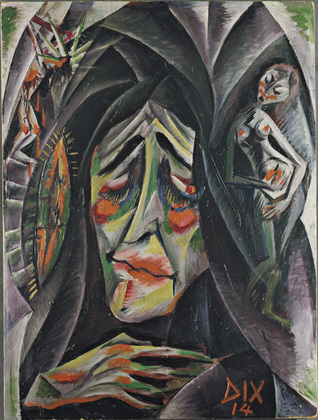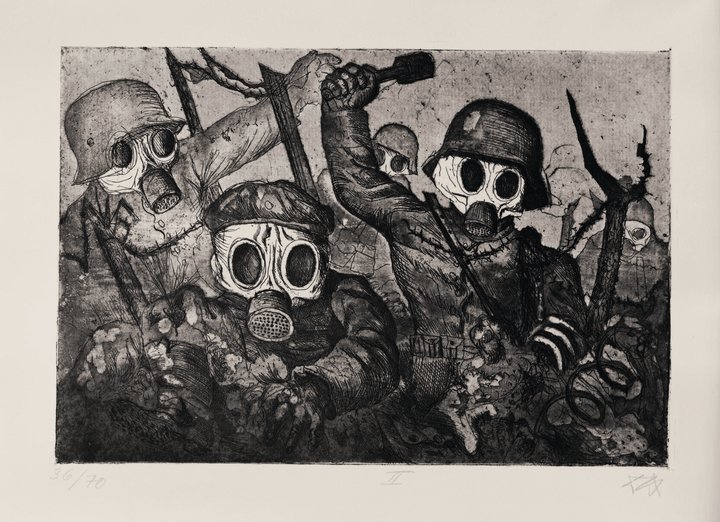Neue Sachlichkeit: Otto Dix

The Nun (1914). This painting helped me start to “get it”. The figure of Christ is almost being pushed up and away into what looks like vaulted cathedral ceilings, a shape suggestive of a vulva fighting for space on that side. The other figure almost seems contemplative and motherly. Her expression seems to suggest consternation, being torn between her commitment to Christ and desires for something more worldly.
I thought I was going to have a bit of a struggle finding an artist I really liked for this period; expressionism is not really my cup of tea, which is not to say I can’t appreciate it, but the fixation on wild use of colour as a foundation element of the movement with no care for rendering ability… that and abstract expressionism are basically the polar opposite of what I care for in terms of aesthetics. Some of it I find gaudy and lacking subtlety, but that could be down to my own ignorance of how to appreciate the movement as a whole.
Triumph of Death (1934).
Otto Dix was a great middle ground for me in that respect. He started first and foremost studying Masters techniques and worked as a portraitist when it had greatly fallen out of fashion at the time. A piece like Triumph of Death above shows what a wide range of art styles he worked in, which is something I can identify with as well. He had a solid foundation of strong classical painting skills before diving into an expressionist phase during the post-WW1 era, and it almost helps me respect the range of his work even more knowing he put that effort in beforehand. I think I struggle to appreciate the work of more “pure” expressionist or fauvist painters sometimes because I just can’t really see the same level of craft in it. I feel badly thinking of it that way sometimes, but it’s the same reason I just don’t care for abstract art either. Maybe I’m not the audience, or perhaps I’m just a boor! Dix’s work helps me get into a space where I can appreciate it a bit more, combining the expressionist approach to emotive colour with compositions I find more compelling than colour bombed landscape scenes.

Wounded Man, Autumn 1916, Bapaume (1924). A copperplate etching from his Der Krieg series. These resonate hugely with me; they’re the perfect mix of expressionist forms, conveying brutal despair and emotion without being unrecognizable or coming off as overly simplistic or lacking artifice.

Stormtroopers Advancing Under Gas (1924). Intensely ominous, you can feel a palpable horror in this etching. His entire series on his wartime trauma is rendered with an unflinching commitment to make sure the viewer understands the loss and sheer animalistic brutality of the realities of the front.

A portion of The Trench. This painting would go missing after being displayed at the Nazi Degenerate Art Exhibition for the twinned crimes of being both expressionistic and anti-war, foreshadowing the horrors the german war machine would unleash in the years to come under the visions of the Nazi new world order.
Sources:
https://www.tate.org.uk/art/lists/five-things-know-otto-dix
https://www.britannica.com/biography/Otto-Dix
https://www.theartstory.org/artist-dix-otto.htm
Picture Sourcing
https://www.moma.org/s/ge/collection_ge/objbyartist/objbyartist_artid-1559_tech-6_role-1_sov.html
https://de.wahooart.com/@@/9GG6WP-Otto-Dix-Der-Triumph-des-Todes,-Triumph-des-Todes
https://hyperallergic.com/375634/otto-dix-wounded-man-autumn-1916-bapaume-1924/
https://www.thedailybeast.com/the-unknown-fate-of-the-painting-that-was-too-dangerous-for-hitler
https://www.tate.org.uk/art/lists/five-things-know-otto-dix

Leave a Reply